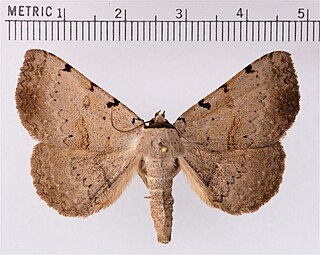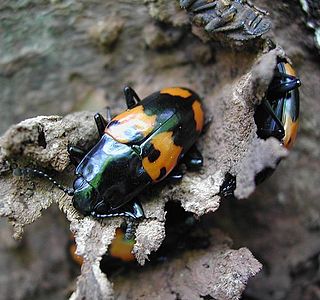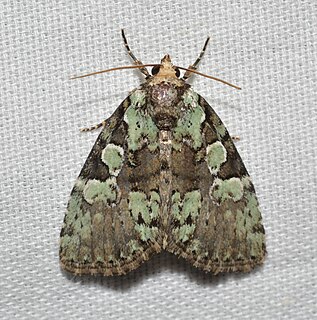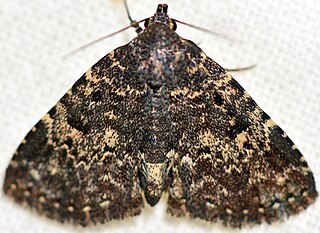
Chytolita is a monotypic litter moth genus of the family Erebidae erected by Augustus Radcliffe Grote in 1873. Its only species, Chytolita morbidalis, the morbid owlet moth or morbid owlet, was first described by Achille Guenée in 1854. It is found in large parts of North America, from coast to coast in the north and south to North Carolina, Texas and Florida in the west. The habitat consists of deciduous woods and edges.

Metalectra is a genus of moths of the family Erebidae described by Jacob Hübner in 1823.

Spiloloma is a monotypic moth genus in the family Erebidae. Its only species, Spiloloma lunilinea, the moon-lined moth, is found in eastern and south-central North America. Both the genus and species were first described by Augustus Radcliffe Grote in 1873.

Catocala mira, the wonderful underwing, is a moth of the family Erebidae. The species was first described by Augustus Radcliffe Grote in 1876. It is found in North America from Manitoba through southern Ontario and Quebec through New Hampshire and Connecticut to Florida, west to Texas and north through Iowa and Illinois.
Drasteria pallescens, the cowhead arches, is a moth of the family Erebidae. The species was first described by Augustus Radcliffe Grote and Coleman Townsend Robinson in 1866. It is found in North America from Alberta and Saskatchewan south to Texas and Baja California.

Euparthenos is a monotypic moth genus in the family Erebidae erected by Augustus Radcliffe Grote in 1876. Its only species, Euparthenos nubilis, the locust underwing, was first described by Jacob Hübner in 1823. The adults resemble some of the underwing moths of genus Catocala, which are fairly close relatives, in color, pattern, and the habit of resting on tree trunks. But E. nubilis can usually be immediately recognized by the four concentric black bands per hindwing, as opposed to one or two in Catocala. Color morphs of E. nubilis with altered pattern are known, however, and these may be hard to recognize without detailed examination.

Isogona tenuis, the thin-lined owlet, is a moth of the family Erebidae. The species was first described by Augustus Radcliffe Grote in 1872. It is found from Ontario, Wisconsin, Ohio and New Jersey, south to Florida and Texas.
Spargaloma is a monotypic moth genus in the family Erebidae. Its only species is Spargaloma sexpunctata, the six-spotted gray. Both the genus and species were first described by Augustus Radcliffe Grote in 1873. It is found from coast to coast in lower Canada south in the east to Florida, Mississippi and Arkansas, in the west to California.

Megalodacne is a genus of fungivorous beetles in the family Erotylidae.

Leuconycta lepidula, the marbled-green leuconycta moth, marbled-green jaspidia or dark leuconycta, is a moth of the family Noctuidae. The species was first described by Augustus Radcliffe Grote in 1874. It is found in North America from Nova Scotia to North Carolina, west to Texas and north to Alberta.

Heliomata cycladata, the common spring moth, is a moth of the family Geometridae. The species was first described by Augustus Radcliffe Grote and Coleman Townsend Robinson in 1866. It is found in eastern North America, with records from southern Ontario, southern Quebec, Maine, New Hampshire, Michigan, Wisconsin to South Carolina, Georgia, Alabama, northern Mississippi and Arkansas.

Haplotinea insectella, the drab clothes moth or fungus grain moth, is a moth of the family Tineidae. It was described by Johan Christian Fabricius in 1794. It is found in all of Europe, except Ireland, the Iberian Peninsula and the western and southern part of the Balkan Peninsula. It is also found in North America. The species is often found in warehouses, granaries, mills and farm buildings.
Elophila ekthlipsis, the nymphula moth, is a moth in the family Crambidae. It was described by Augustus Radcliffe Grote in 1876. It is found in North America, where it has been recorded from the Great Lakes area, including Indiana, Maine, Michigan, Minnesota, New Brunswick, New Hampshire, Ohio, Ontario, Quebec and Wisconsin. The habitat consists of ponds and marshes.

Ostrinia penitalis, the American lotus borer, is a moth in the family Crambidae. It was described by Augustus Radcliffe Grote in 1876. It is found from Mexico, through Central America to Amazonas, Brazil. It is also found in North America, where it has been recorded from Quebec to British Columbia and most of the United States. The habitat consists of marshes and pondsides.

Metalectra tantillus, the black fungus moth, is a moth of the family Erebidae. The species was first described by Augustus Radcliffe Grote in 1874. It has been recorded from the US states of Alabama, Florida, Georgia, Illinois, Iowa, Kentucky, Maryland, Mississippi, New Jersey, North Carolina, Ohio, Oklahoma, Pennsylvania, South Carolina, Tennessee, Texas, West Virginia and Wisconsin.
Mecyna submedialis, the orange-toned mecyna moth, is a moth in the family Crambidae. It was described by Augustus Radcliffe Grote in 1876. It is found in North America, where it has been recorded from Ontario and Michigan, south to Florida and west to Arkansas. It has also been recorded from Alberta.

Metalectra diabolica, the diabolical fungus moth, is a moth of the family Erebidae. The species was first described by William Barnes and Foster Hendrickson Benjamin in 1924. It is found in North America, where it has been recorded from North Carolina to Florida and Arkansas to Texas.

Metalectra quadrisignata, the four-spotted fungus moth, is a species of moth in the family Erebidae. It is found in North America, where it has been recorded from Arizona, Florida, Georgia, Indiana, Iowa, Kentucky, Louisiana, Maine, Maryland, Massachusetts, Michigan, New Brunswick, New Hampshire, New Jersey, North Carolina, Ohio, Oklahoma, Pennsylvania, Quebec, South Carolina, Tennessee, Texas, Virginia, West Virginia and Wisconsin. The species was described by Francis Walker in 1858.
Metalectra bigallis is a species of moth in the family Erebidae. It is found in North America.
Metalectra albilinea, the white-lined fungus moth, is a species of moth in the family Erebidae. It is found in North America.














